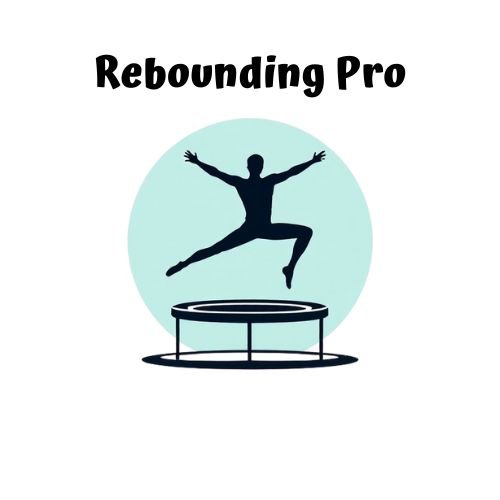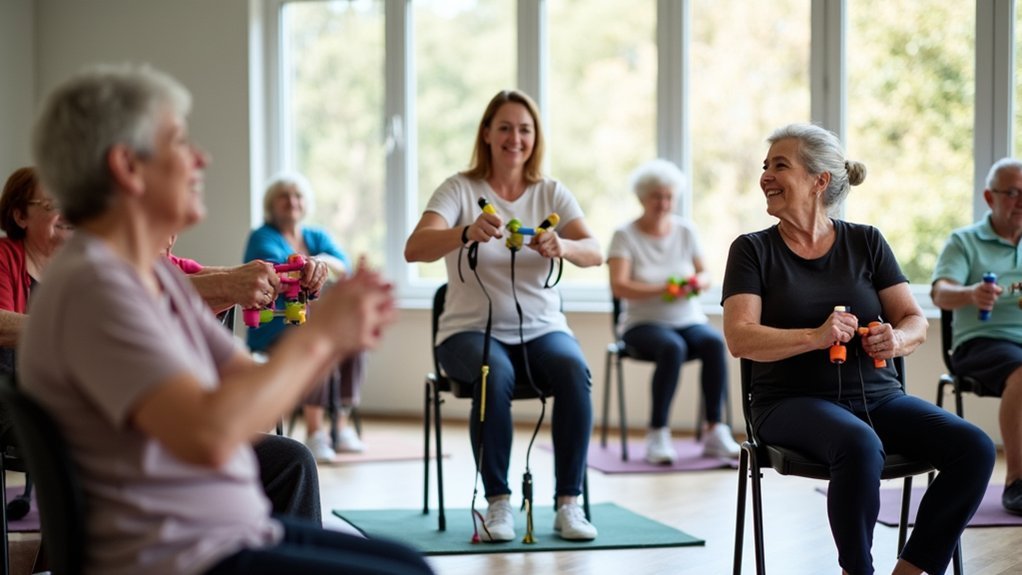For lymphedema management, try these gentle rebounding exercises: 1) Basic health bounce, lifting one heel at a time while maintaining stability; 2) Seated rebounding with light bouncing motions if you have limited mobility; and 3) Walking in place on the rebounder while incorporating arm movements. Always wear compression garments if prescribed and start with just 5 minutes daily, gradually increasing to 20 minutes. These techniques stimulate lymphatic flow in ways traditional exercises can't.
Rhythmic Bouncing: The Foundation of Rebounding for Lymphatic Drainage

While many exercise options exist for lymphedema management, rhythmic bouncing stands out as one of the most effective and accessible techniques.
Using a mini-trampoline or rebounder, you'll create gentle, repetitive movements that stimulate your lymphatic system. The vertical motion creates a unique pumping effect that traditional exercises can't match.
The gentle up-and-down motion on a rebounder activates lymph flow in ways that walking or swimming simply cannot achieve.
As you bounce, the alternating gravitational forces help move lymph fluid through your body, stimulating lymph nodes and enhancing toxin removal. Unlike running or jumping on hard surfaces, rebounding is surprisingly gentle on your joints.
This gentle impact makes rebounding an ideal exercise for those who spend long hours sitting, as prolonged desk work can significantly impair proper lymphatic circulation.
Start with a basic health bounce by simply lifting one heel then the other while maintaining balance. You can progress to walking in place or adding arm movements as you build confidence.
Begin with short 5-minute sessions and gradually increase to 20 minutes daily.
Seated Rebounding: Safe Alternatives for Limited Mobility
For those with limited mobility or severe lymphedema symptoms, traditional rebounding exercises may seem impossible.
Fortunately, seated rebounding offers an accessible alternative that still delivers significant lymphatic benefits.
Choose a rebounder with a stability bar or one specifically designed for seated use. You'll still experience improved lymphatic flow and reduced swelling while engaging core and leg muscles from a seated position.
Start with gentle bouncing for short sessions, gradually increasing duration as your comfort allows. Seated exercises like double bounces and marching are excellent starting points for those new to rebounding therapy.
Before beginning, consult your healthcare provider or lymphedema therapist to verify this approach aligns with your treatment plan.
They can help develop a personalized routine that incorporates breathing techniques and varied movements like leg lifts or side bends to maximize effectiveness while respecting your physical limitations.
Progressive Rebounding Techniques: From Beginner to Advanced

Progressive rebounding techniques allow anyone with lymphedema to build their fitness journey systematically, regardless of their starting point.
If you're new to rebounding, start with gentle toe bounces, modified steps, and short sessions of 1-2 minutes. Incorporate deep breathing to enhance lymphatic flow.
As you build confidence, increase your duration and add gentle leg swings or arm movements. Progress to varying jump heights and mixing movement patterns to challenge different muscle groups. The inclusion of special exercises performed with compression can significantly improve lymphatic circulation.
Advanced rebounders can incorporate higher jumps, complex patterns, and dynamic arm work. Try interval training with alternating periods of rest and more intense rebounding.
Always wear compression garments if recommended, warm up properly, and listen to your body—stopping if you experience discomfort.
Consult your healthcare provider before beginning any new exercise routine.
Frequently Asked Questions
Can I Rebound During Active Lymphedema Flare-Ups?
During active lymphedema flare-ups, you should consult your doctor first. They'll determine if rebounding is safe for your condition. You'll likely need to modify intensity or temporarily avoid rebounding until the flare-up subsides.
How Long Should Each Rebounding Session Last for Optimal Benefits?
For ideal benefits, aim for 10-15 minute rebounding sessions. You'll get effective lymphatic stimulation in this timeframe. If that's too long, try 5-10 minute sessions spread throughout your day for consistent benefits.
Will Rebounding Affect My Compression Garment's Effectiveness?
No, rebounding won't reduce your compression garment's effectiveness. You should continue wearing it while rebounding as the combined approach actually enhances lymphatic flow and provides better management of your condition than either alone.
Are There Specific Times of Day Best for Lymphedema Exercises?
Morning is ideal for exercises targeting your head, neck, and face to reduce overnight swelling. Evening is better for leg exercises to alleviate daytime fluid pooling. Most importantly, you'll benefit from maintaining consistent daily routines.
Can Medications for Lymphedema Impact Exercise Tolerance or Effectiveness?
Yes, your medications for lymphedema can affect exercise tolerance by impacting circulation, fluid retention, or mobility. Always consult your healthcare provider about how your specific medications might influence your exercise capacity and effectiveness.
In Summary
You've now discovered three gentle rebounding exercises that can improve your lymphatic flow while managing lymphedema. Start with rhythmic bouncing to build your foundation, try seated options if you're mobility-limited, or explore progressive techniques as you gain confidence. Remember to listen to your body, wear compression garments, and check with your healthcare provider. These low-impact exercises offer a gentle yet effective way to support your lymphatic health.





Leave a Reply